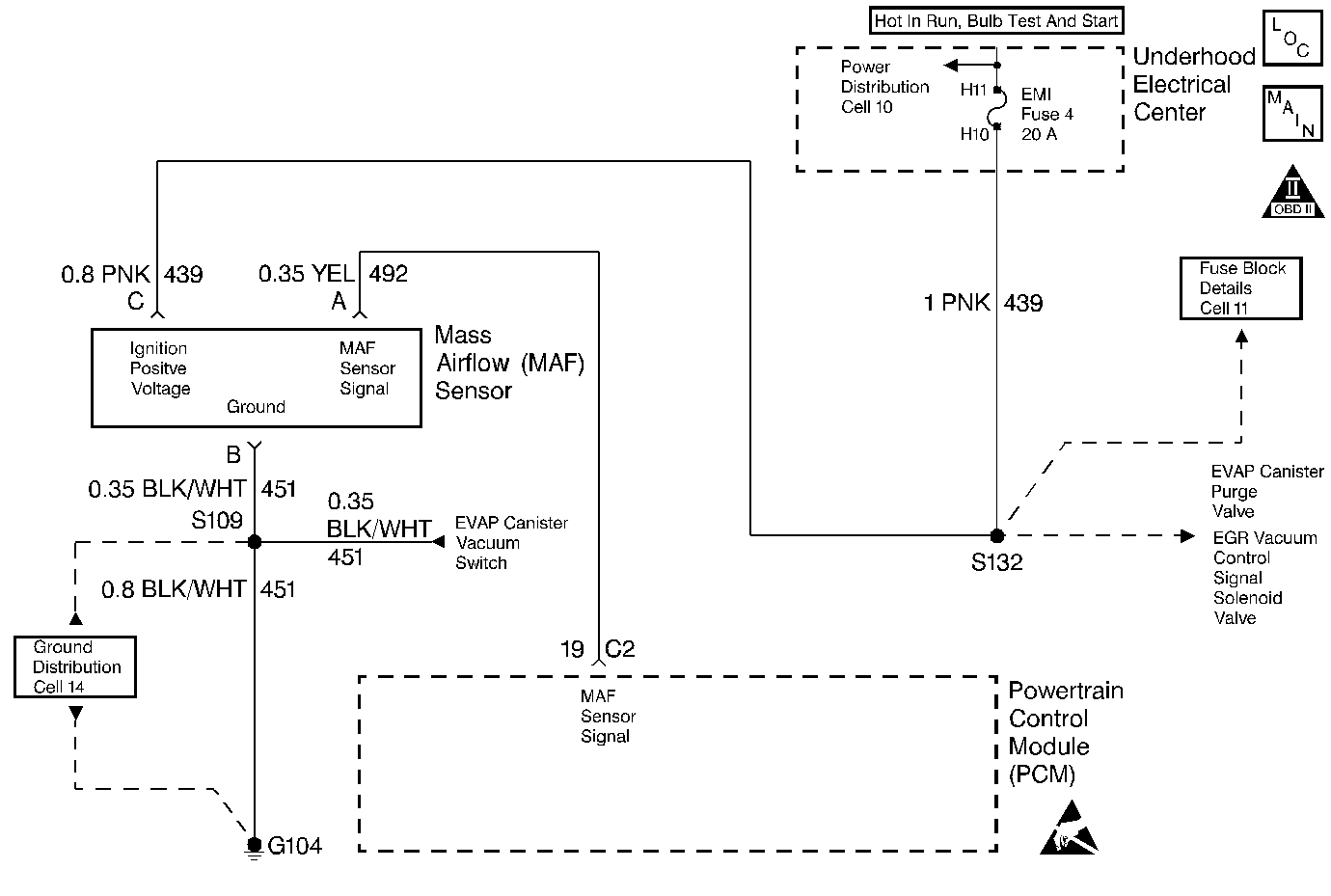
Circuit Description
The Mass Air Flow (MAF) sensor measures the amount of air that is ingested by the engine. Direct measurement of air entering the engine is more accurate than calculating airflow from MAP, IAT and RPM (speed/density). The MAF sensor has a battery feed, ground and signal circuit.
The MAF sensor used on this vehicle is a hot wire type and is used to measure air flow rate. The MAF output frequency is a function of the power required to keep the air flow sensing elements (hot wires) at a fixed temperature above ambient temperature. Air flowing through the sensor cools the sensing elements. The amount of cooling is proportional to the amount of air flow. As air flow increases, a greater amount of current is required to maintain the hot wires at a constant temperature. The MAF sensor converts the changes in current draw to a frequency signal read by the PCM. The PCM calculates air flow (grams per second) based on this signal.
The PCM monitors the MAF sensor frequency and can determine if the sensor is stuck low, stuck high, not providing the airflow value expected for a given operating condition, or that the signal appears to be stuck based on a lack of signal variation expected during normal operation. This diagnostic checks for too high an airflow rate. When the PCM detects that the MAF sensor grams per second is above a predetermined value, this DTC will set.
Conditions for Setting the DTC
| • | Engine running. |
| • | Engine speed greater than 50 RPM. |
| • | Ignition voltage greater than 10 volts. |
| • | Mass Air Flow greater than 300 grams per second. |
| • | All conditions met for 1 second. |
Action Taken When the DTC Sets
| • | The PCM will illuminate the Malfunction Indicator Lamp (MIL) when the diagnostic runs and fails. |
| • | The PCM will utilize speed density (RPM, MAP, IAT) for fuel management. |
| • | The PCM will record operating conditions at the time the diagnostic fails. This information will be stored in the Freeze Frame and/or Failure Records. |
Conditions for Clearing the MIL/DTC
| • | The PCM will turn the MIL OFF after three consecutive drive trips that the diagnostic runs and does not fail. |
| • | A last test failed (Current DTC) will clear when the diagnostic runs and does not fail. |
| • | A History DTC will clear after forty consecutive warm-up cycles, if no failures are reported by this or any other emission related diagnostic. |
| • | PCM battery voltage is interrupted. |
| • | Using a Scan tool. |
Diagnostic Aids
| • | Water entering the air intake system that reaches the MAF sensor could cause this DTC to set. The water rapidly cools the hot wires in the sensor, causing a false indication of excessive airflow. Check the following areas for evidence (witness marks) of water intrusion: |
| • | AIR system. |
| - | Poor connections. |
| - | Mis-routed harness. |
| - | Rubbed through wire insulation. |
| - | Broken wire inside the insulation. |
For intermittents, refer to Symptoms .
Test Description
Number(s) below refer to step numbers on the diagnostic table.
-
Monitoring MAF sensor grams per second (gm/s) will determine if the fault is present or the malfunction is intermittent. For any test that requires back probing the PCM or component harness connectors, must use the Connector Test Adapter Kit J 35616-A. Using this kit will prevent any damage to the harness connector terminals.
-
Using Freeze Frame and/or Failure Records data may aid in locating an intermittent condition. If the DTC cannot be duplicated, the information included in the Freeze Frame and/or Failure Records data can be useful in determining how many miles since the DTC set. The Fail Counter and Pass Counter can also be used to determine how many ignition cycles the diagnostic reported a pass and/or a fail. Operate vehicle within the same freeze frame conditions (RPM, load, vehicle speed, temperature etc.) that were noted. This will isolate when the DTC failed.
-
This checks for electro-magnetic interference on the MAF sensor signal circuit. There should be no signal indicated on the scan tool with the sensor disconnected.
Step | Action | Value(s) | Yes | No | ||||
|---|---|---|---|---|---|---|---|---|
1 | Was the Powertrain On-Board Diagnostic (OBD) System Check performed? | -- | ||||||
Is MAF gm/s above the specified value? | 300 gm/s | |||||||
Does the scan tool indicate that this diagnostic failed this ignition? | -- | Go to Diagnostic Aids | ||||||
Does the scan tool indicate MAF gm/s at the specified value? | 1.9 gm/s | |||||||
5 |
Was a problem found and corrected? | -- | ||||||
6 | Replace the MAF sensor. Refer to Mass Airflow Sensor Replacement . Is the action complete? | -- | -- | |||||
7 |
Was a problem found and corrected? | -- | ||||||
8 |
Was a problem found and corrected? | -- | ||||||
9 |
Important:: Replacement PCM must be programmed. Refer to Powertrain Control Module Replacement/Programming . Replace the PCM. Is the action complete? | -- | -- | |||||
10 |
Does the scan tool indicate that this test ran and passed? | -- | ||||||
11 | Using the scan tool, select Capture Info, Review Info. Are any DTCs displayed that have not been diagnosed? | -- | Go to the applicable DTC table. | System OK |
